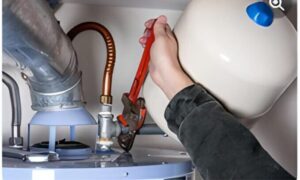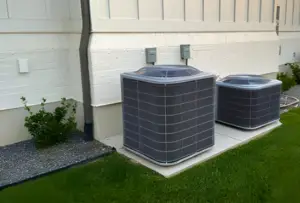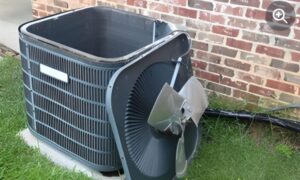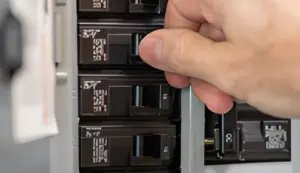As the summer heat intensifies, the last thing you want is for your AC circuit breaker to keep tripping, leaving you in a sweltering environment.
The frustration and inconvenience can be overwhelming, but fear not, as there are troubleshooting steps you can take to address this issue.
In this article, we will explore the common causes behind AC circuit breaker trips and provide you with insights on how to handle them.
From power surges to dirty condenser coils, loose wires, and fan motor malfunctions, we will delve into the potential culprits and offer guidance on resolving them.
So, if you're tired of sweating it out and seeking a cool and comfortable indoor atmosphere, read on to uncover the secrets to troubleshooting your AC circuit breaker woes.
Turn off Air Conditioning System at Thermostat(S)
To begin troubleshooting an AC circuit breaker tripping issue, the first step is to turn off the air conditioning system at the thermostat(s). This ensures that the power to the AC unit is completely cut off, allowing for a safe inspection and repair process. By turning off the system at the thermostat(s), you eliminate any potential electrical hazards that may arise during the troubleshooting process. It is crucial to follow this step before proceeding to the next troubleshooting steps.
Once the system is turned off, you can then proceed to inspect the electrical panel and reset the AC circuit breaker switch to the ON position. This initial step sets the foundation for a systematic and safe troubleshooting process.
Check AC Circuit Breaker Switch at Electrical Panel
The next step in troubleshooting an AC circuit breaker tripping issue is to examine the AC circuit breaker switch at the electrical panel. This switch controls the flow of electricity to the air conditioning system.
Start by ensuring that the switch is in the ON position. If it is already on, turn it off and then back on again to reset the internal circuit breaker. Wait for approximately 30 minutes before turning the air conditioner back on.
If the circuit breaker immediately trips again or the AC fails to come back on, it is recommended to contact a professional for further diagnosis and repair. It is important to avoid attempting any repairs without proper training to ensure safety.
Allow Circuit Breaker to Reset for 30 Minutes
After examining the AC circuit breaker switch at the electrical panel, the next step in troubleshooting an AC circuit breaker tripping issue is to allow the circuit breaker to reset for a duration of 30 minutes. This period of time is necessary to ensure that the internal circuit breaker has fully reset and is ready to handle the electrical load from the air conditioning system.
During this 30-minute waiting period, it is important to keep the air conditioner turned off at the thermostat(s) to prevent any additional strain on the circuit breaker.
After the 30 minutes have elapsed, the air conditioner can be set back to the COOL mode. If the circuit breaker immediately trips again or the AC fails to come back on, it is recommended to contact a professional for further diagnosis and repair.
Set Air Conditioner Back to COOL
To resume normal operation, the next step in troubleshooting an AC circuit breaker tripping issue is to adjust the air conditioner settings back to the COOL mode. After allowing the internal circuit breaker to reset for 30 minutes, it is important to set the air conditioner back to the COOL mode to ensure proper functioning.
This step is crucial as it allows the system to regulate the temperature and provide cool air to the desired space. By setting the air conditioner back to COOL, you are allowing the system to resume its intended operation and provide cooling comfort.
If the AC circuit breaker continues to trip or the air conditioner fails to come back on, it is recommended to seek professional assistance for diagnosis and repair.
Call Professional for Immediate Tripping or Failure
When facing immediate tripping or failure of the AC circuit breaker, it is imperative to seek the expertise of a qualified HVAC professional for prompt diagnosis and repair.
The tripping or failure of the AC circuit breaker is often indicative of underlying electrical issues within the air conditioning system that require specialized knowledge and equipment to address safely and effectively.
Attempting to troubleshoot or repair these problems without proper training can lead to further damage or even injury.
By calling a professional, you can ensure that the issue is accurately diagnosed and resolved, preventing any potential hazards and restoring the functionality of your AC system.
Trusting a qualified HVAC professional guarantees that the necessary expertise and experience will be applied to identify the root cause of the tripping or failure, allowing for an efficient and reliable repair.
Power Surge or Clogged Air Filter
The occurrence of a power surge or a clogged air filter can lead to tripping of the AC circuit breaker, which requires prompt attention and resolution by a qualified HVAC professional.
Power surges, often caused by lightning or electrical grid fluctuations, can overload the circuit and trip the breaker. In such cases, the breaker needs to be reset, and the cause of the power surge should be investigated to prevent future issues.
On the other hand, a clogged air filter restricts airflow, causing the AC system to work harder and draw more power. This increased power draw can trip the circuit breaker. Regular maintenance, including cleaning or replacing the air filter, can prevent this problem.
In any case, it is important to consult a professional to properly diagnose and address these issues.
Dirty Condenser Coil
A dirty condenser coil in an air conditioning system can cause the AC circuit breaker to trip and should be addressed promptly to ensure proper functioning. Neglecting yearly AC preventative maintenance can lead to a dirty condenser coil. When the condenser coil is dirty, it impairs heat transfer and makes the system work harder, resulting in excessive power draw. As a result, the AC circuit breaker may trip.
To resolve this issue, regular coil cleaning is necessary. It is recommended to include air conditioner coil cleaning as part of a maintenance plan. By keeping the condenser coil clean, the system can operate efficiently and prevent unnecessary tripping of the AC circuit breaker.
Loose Wire, Short, or Electrical Component Failure
Electrical issues within the air conditioner can cause the AC circuit breaker to trip, necessitating professional assistance to diagnose and resolve loose wire, short, or electrical component failures.
These issues can arise from loose connections, failed capacitors, or shorts in the wiring. It is crucial to seek professional help to safely fix these problems, as attempting repairs without proper training can be hazardous.
When the AC circuit breaker trips, it is a clear indication that there is an underlying electrical issue that needs to be addressed. Only a qualified HVAC professional has the expertise and knowledge to identify and rectify these problems effectively.
Promptly contacting an HVAC professional will ensure the timely resolution of loose wire, short, or electrical component failures, restoring the proper functioning of the air conditioning system.
Fan Motor Malfunction
An AC circuit breaker tripping can indicate a malfunction in the fan motor, requiring the expertise of an HVAC professional to diagnose and resolve the issue.
A clogged filter can cause the AC circuit breaker to trip due to excessive power draw. Additionally, dirt on the fan blades can slow down the fan and strain the motor. Cleaning the fan blades may resolve the issue.
However, if the motor itself malfunctions, it will need to be replaced by a professional. Seeking assistance from an AC service technician is crucial for fan motor problems.
It is important to avoid attempting repairs without proper training to ensure safety and prevent further damage to the system.
Frozen Evaporator Coil or Compressor Failure
The occurrence of a frozen evaporator coil or compressor failure in an air conditioning system can be indicative of significant issues that require immediate attention from a professional HVAC technician. A frozen evaporator coil can result from various factors, such as restricted airflow, low refrigerant levels, or a malfunctioning blower motor. When the evaporator coil freezes, it hinders the heat transfer process, leading to reduced cooling efficiency and potential compressor failure.
Compressor failure, on the other hand, can occur due to electrical problems, refrigerant leaks, or excessive strain caused by a frozen coil. Both of these issues require the expertise of a qualified technician who can diagnose the root cause and perform the necessary repairs or replacements to restore the functionality of the air conditioning system.
Frequently Asked Questions
How Can I Prevent Power Surges From Tripping My AC Circuit Breaker?
To prevent power surges from tripping your AC circuit breaker, consider installing a surge protector specifically designed for air conditioning systems. This device will help protect your AC unit from voltage fluctuations and ensure uninterrupted cooling performance.
What Are the Signs of a Clogged Air Filter That Could Cause the AC Circuit Breaker to Trip?
Signs of a clogged air filter that could cause the AC circuit breaker to trip include reduced airflow, decreased cooling efficiency, increased energy consumption, and potential damage to the air conditioning system. Regular filter maintenance is essential to prevent these issues.
Can a Dirty Condenser Coil Be Cleaned by the Homeowner, or Is Professional Assistance Necessary?
Cleaning a dirty condenser coil can be done by a homeowner as part of a maintenance plan. However, professional assistance is recommended for proper cleaning and to avoid any damage to the coil or other components.
Are There Any DIY Troubleshooting Steps I Can Take to Fix a Loose Wire or Electrical Component Failure?
When faced with a loose wire or electrical component failure in your AC system, it is crucial to seek professional assistance. Attempting DIY troubleshooting without proper training can be dangerous. Contact a qualified HVAC professional for safe and effective repairs.
How Can I Determine if the Fan Motor in My AC Unit Is Malfunctioning and Needs to Be ReplACed?
To determine if the fan motor in your AC unit is malfunctioning and needs to be replaced, observe if the fan blades are clean and functioning properly. If the motor itself is faulty, seek assistance from a qualified HVAC professional for replacement.
Conclusion
In conclusion, troubleshooting and addressing AC circuit breaker trips is essential for maintaining a comfortable indoor environment during hot summer months.
Power surges, clogged air filters, dirty condenser coils, loose wires, and fan motor malfunctions are common causes of circuit breaker trips.
Regular maintenance and professional assistance may be required to resolve these issues.
By understanding the potential causes and following the troubleshooting steps, individuals can effectively resolve AC circuit breaker problems and ensure a cool and comfortable living space.








